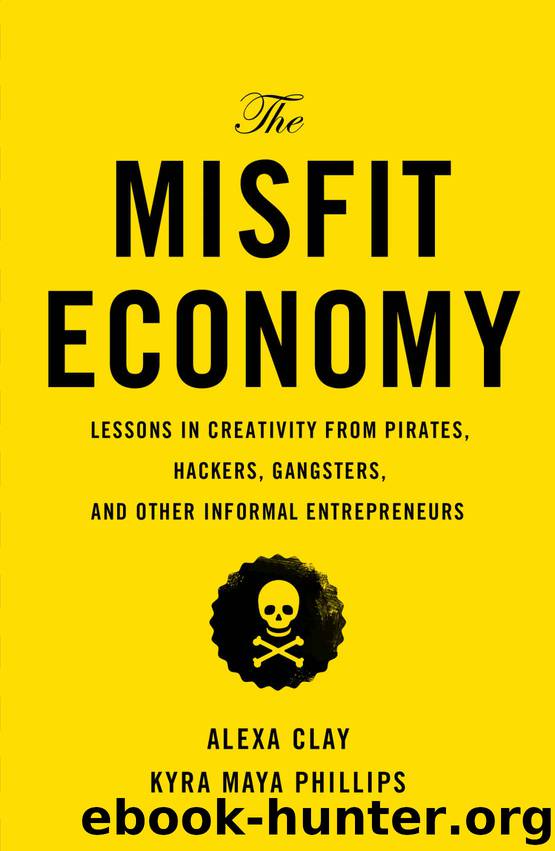The Misfit Economy: Lessons in Creativity from Pirates, Hackers, Gangsters and Other Informal Entrepreneurs by Alexa Clay & Kyra Maya Phillips

Author:Alexa Clay & Kyra Maya Phillips
Language: eng
Format: mobi
Publisher: Simon & Schuster
Published: 2015-06-22T14:00:00+00:00
A RELUCTANT HACKER, A LATE-BLOOMING MISFIT
Gary Slutkin, M.D., was never a misfit. A physician by training, a “very conventional training,” he added, Dr. Slutkin had devoted himself to designing behavior change and epidemic control programs. As a chief resident at the prestigious San Francisco General Hospital, Slutkin worked on a tuberculosis prevention program. After two years, new cases of TB infection in the surrounding area dropped by over 50 percent, and the rate of those completing TB therapy increased from 50 to 95 percent.
Next stop was Somalia. When Slutkin told his mentor at San Francisco General Hospital where he was going, his mentor told him it was the biggest mistake he could ever make, that he was jeopardizing his career.
In Somalia, Slutkin worked for the country’s director of primary health care and assisted in preventing the spread of tuberculosis and a deadly cholera outbreak. He landed in the middle of a dire situation, with more than a million refugees occupying forty camps. Because his team had limited resources, they ended up recruiting and training refugees to become specialized health workers. Similar to Florence Nightingale’s introduction of the nursing profession, this approach introduced a new category of worker into health systems: the indigenous worker who already had the access and trust of the local population.
After three years in Somalia, Slutkin took a position at the World Health Organization, where he worked to fight the HIV/AIDS epidemic in Uganda. Overall, Slutkin spent nearly ten years in fifteen countries in Africa and Europe as a major leader in the battle against infectious disease.
His personal life and professional life suffered. After ten years on high alert, he was exhausted, physically and mentally, and feeling emotionally isolated. But he was gratified to see extraordinary breakthroughs.
He returned to the United States and soon found himself asking, “What next?” He started hearing about kids shooting each other. “I was reading these horrific stories of ten- and twelve-year-old kids killing each other in the streets, and I asked people what was being done about it.” It was a simple question, one that might be posed by any concerned citizen. But it was a question that Slutkin would spend the next fifteen years attempting to answer.
Slutkin was stunned and disappointed by the so-called solutions that existed for treating violence. “We knew that punishment wasn’t a main driver of behavior,” he told us. “This was a problem that was stuck.” Discouraged, Slutkin began to study patterns of violent outbreaks and made a startling observation: Violence spreads much like infectious disease. “What I saw in the maps of violence I studied was characteristic clustering—just like the maps that I had seen in other epidemics, such as cholera.” That was Slutkin’s “aha moment.” “I thought, what if we started treating violence as a contagion?”
One of the biggest and most insidious plagues on our society is violence. Yet too often the discourse focuses on labeling the violent individuals as deviants or “evil.” What if, Slutkin wondered, we removed the labels and the judgment
Download
This site does not store any files on its server. We only index and link to content provided by other sites. Please contact the content providers to delete copyright contents if any and email us, we'll remove relevant links or contents immediately.
| Anthropology | Archaeology |
| Philosophy | Politics & Government |
| Social Sciences | Sociology |
| Women's Studies |
Cecilia; Or, Memoirs of an Heiress — Volume 1 by Fanny Burney(32062)
Cecilia; Or, Memoirs of an Heiress — Volume 3 by Fanny Burney(31458)
Cecilia; Or, Memoirs of an Heiress — Volume 2 by Fanny Burney(31409)
The Great Music City by Andrea Baker(30781)
We're Going to Need More Wine by Gabrielle Union(18633)
All the Missing Girls by Megan Miranda(14737)
Pimp by Iceberg Slim(13779)
Bombshells: Glamour Girls of a Lifetime by Sullivan Steve(13685)
Fifty Shades Freed by E L James(12915)
Talking to Strangers by Malcolm Gladwell(12875)
Norse Mythology by Gaiman Neil(12828)
For the Love of Europe by Rick Steves(11476)
Crazy Rich Asians by Kevin Kwan(8888)
Mindhunter: Inside the FBI's Elite Serial Crime Unit by John E. Douglas & Mark Olshaker(8702)
The Lost Art of Listening by Michael P. Nichols(7160)
Enlightenment Now: The Case for Reason, Science, Humanism, and Progress by Steven Pinker(6874)
The Four Agreements by Don Miguel Ruiz(6319)
Bad Blood by John Carreyrou(6277)
Weapons of Math Destruction by Cathy O'Neil(5832)
